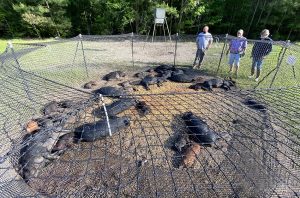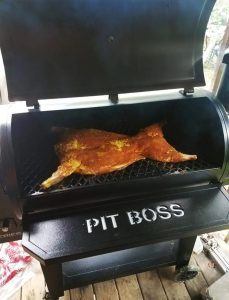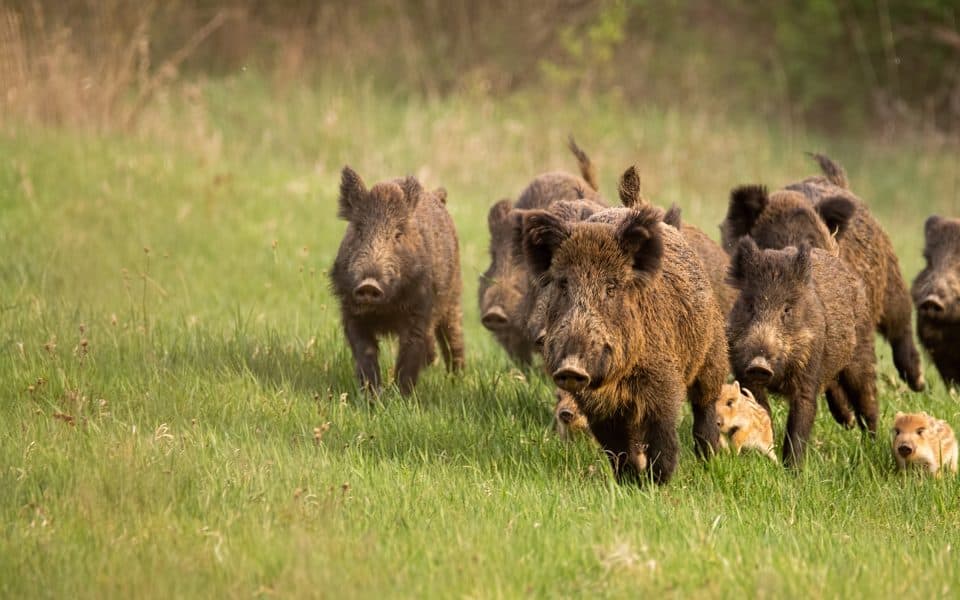There are two types of wild land – the properties that have feral hogs on them, and the lands that are about to have feral hogs on them. Feral hogs have become a major threat to landowners and wildlife. Landowners have found that once they have wild pigs on their lands, more than likely, they’ll have a hard time getting rid of them. As soon as you get rid of the ones you have others move in.
The average wild hog weighs from 50 to 250 pounds and possesses a high degree of intelligence. They have a very-keen sense of smell, with the ability to smell humans up to seven miles away, but poor eyesight. They move primarily at night, and many have earned their doctorate in “hunter dodging.”
A friend of mine, Dr. Randy Britt of Birmingham, Alabama, took a wild boar weighing 1,172 pounds some years ago that had tusks six inches long. A Georgia hunter took one nicknamed “Hogzilla,” due to its immense size. Hong Kong even had a wild boar named “Pigzilla” that terrorized the community for a number of years. Morocco and other countries around the world consider wild pig hunting a national sport.
What’s the Origin of Feral Hogs?

Many know that in the original Thirteen Colonies, settlers brought pigs with them from England and often allowed them to run free where they mated and increased their numbers, particularly in swampy areas. Much of the Southeast’s populations descended from the pigs brought by Spanish explorers in the 1500s to feed their troops. California’s wild pigs originated from free-ranging domestic pigs brought by Spanish settlers in the 1700s. Also stockings of Eurasian wild boars were made by hunters in the 1920s and again in the 1950s.
How Bad Is the Feral Hog Problem?

Dr. Steve Ditchkoff, a professor of wildlife ecology at Auburn University, headed-up the first national conference on wild pigs that took place in Mobile, Alabama, in May, 2006. Thirty-two U.S. and Australian researchers attended, and their concerns about wild hogs are more far reaching today. Their findings may surprise you.
“Nationwide, feral hogs are a growing problem,” Ditchkoff reports. “The most-serious issues with feral hogs are primarily throughout the Southeast, Texas, California and Hawaii. About 47 of the 50 states now have problems with feral hogs. The estimated crop damage from feral pigs is more than $1.5 billion per year.”
The Caribbean islands, Canada and Mexico also have growing wild pig problems. Ditchkoff explains that feral hogs compete with native wildlife for food and often monopolize acorn and soft-mast crops. Feral hogs also eat turtles, reptiles and amphibians – including endangered toads and lizards. They enjoy a diet too of rats, rabbits, nutria, butterfly larvae, centipedes, crabs, cockroaches, earthworms, grasshoppers, crickets and turkey eggs and poults. “Once we came across a wild pig actually eating a live deer fawn,” said Ditchkoff. Feral hogs even have had a devastating impact on sea turtle nests in some places.
At Florida’s Eglin Air Force Base (EAFB) that contains some of the largest tracts of the 1% of Florida’s seepage slopes that remain, feral swine damage has threatened this wetland habitat. Researchers from the USDA and Eglin Natural Resources have found that swine damage to EAFB’s seepage slopes closed to hunting averaged 25%, over twice the 10.9% damage in parts open to hunting. The combined pig damage to both types of areas cost $5.3 million in only two years. In some parts of Texas, landowners consider wild hogs as the second-worst predator of newborn livestock, after the coyote. Feral hogs also root-up and destroy green fields, crops and dirt roads.
“The feral-hog population is creating more damage to the environment and forest recreation lands than we realize,” Ditchkoff says. “Researchers also have a huge growing concern about feral hogs spreading disease to domestic swine. Feral hogs can destroy complete ecosystems. For instance, in Hawaii, where fresh water is a very-precious commodity, feral hogs can alter water flow and nutrient cycling to disrupt the quality of the water, costing Hawaii billions each year. I don’t believe we have a full grasp yet of how destructive the growing feral-hog population will be on nutrient cycling, water quality and direct predation on individual species. In Hawaii, hogs actually have caused the extinction of certain species, and this potential exists here on the mainland.”
Scientific studies have found that wild pigs compete with native wildlife for resources, including deer and turkeys. They lay waste to fauna, plunder and pillage small mammals, as well as babies of large mammals and destroy the nests of ground-nesting birds like quail, woodcocks, grouse and turkeys. Wild pigs are able to reproduce at eight months old. The high reproductive rate of wild pigs and having up to two litters per year of four to twelve piglets means landowners must constantly be fighting to eliminate them.
Controlling Pig Population

Some states don’t consider feral hogs as a “game species” but instead a “nuisance animal.” “However, more states are studying how they can make hunting feral hogs more appealing to hunters,” Ditchkoff advises. “In some states, you can even hunt hogs by spotlights at night with a permit. And, in Georgia and some other places, you can hunt hogs over bait.”
In Texas, feral pigs are being removed by hunters shooting from helicopters. But when I asked Ditchkoff how effective hunting is at reducing feral-hog populations, he replied, “Hunting is not effective, because hogs are intelligent animals and extremely sensitive to hunting pressure. Hogs may simply relocate away from an area with hunting pressure into a place without hunting pressure.”
My friend, Forrest Armke, the longtime manager of the Ford Ranch in Brady, Texas, instituted an intense hog-removal program there. He soon saw a dramatic increase in deer and turkey population. “We knew that wild hogs not only killed and ate our turkey poults but also our deer fawns at birth. The ranch continued to conduct this program for years, resulting in an increase in the numbers of fawns and turkeys surviving on the ranch.”
Researcher John Dickson studied the wild hogs on the Bayou Cocodrie National Wildlife Refuge (NWR) in Louisiana and learned that despite approximately 5,000 visits by hunters each year, nocturnal behavior, wariness and dense palmetto prevented public hunting from effectively controlling the NWR’s wild-hog population. Trapping is more effective than hunting, and right now, it’s the best tool available for removing hogs.
Ditchkoff states, “Research proves that unless you spend a huge amount of money, manpower and effort, you can’t reduce hog numbers simply by trapping and/or hunting.”
Some states conduct hog trapping seminars for landowners and hunting clubs through their Cooperative Extension Services, including Alabama, Georgia, Mississippi, Arkansas, Texas and Missouri to name a few. Feral hogs are much like cockroaches – you may get rid of them temporarily but they seem to always return.
What’s the Most-Effective Protection Against Hog?
 “The best method for keeping feral hogs out of any area is fencing your entire property, which is expensive,” Ditchkoff emphasizes. “The next-best method is to get the hogs feeding regularly inside a trap to accustom them to going into the trap night after night for several weeks. Then, set the trap with a hard trigger to hopefully catch every hog possible in the sounder when the door on the trap falls.”
“The best method for keeping feral hogs out of any area is fencing your entire property, which is expensive,” Ditchkoff emphasizes. “The next-best method is to get the hogs feeding regularly inside a trap to accustom them to going into the trap night after night for several weeks. Then, set the trap with a hard trigger to hopefully catch every hog possible in the sounder when the door on the trap falls.”
A cooperative effort of extensive hunting and trapping between adjacent landowners will have a greater impact on reducing and/or eliminating hog numbers than any individual landowner trying to solve the hog problem alone. Because of that, Missouri set-up a 16-member task force to coordinate and attack the growing wild-hog problem there. If you’re using a portion or all of your land for forest recreation, including hunting and/or observing wildlife, and spot hogs on your property, take action immediately to remove them through trapping and hunting.
How Feral Pigs Impact Turkey Populations
Scientists long have touted the advantage of feral hog removal to help more wild turkeys survive. Auburn University has conducted a new study for the past three years lead by Matt McDonough that shows several startling facts:
- Wild turkey numbers increased by 70% when the number of feral hogs removed was equal to the initial population of hogs present;
- Wild turkey numbers increased, sometimes drawing adult turkeys from other places, if the hog numbers were greatly reduced on a property;
- Landowners had to remove at least 50% to 70% of hog populations each year on their properties to bring the hogs under control; and
- Pig density reduction meant less turkey nest predation and more acorns for turkeys and deer to eat.
McDonough learned that removing predators like wild hogs through trapping and catching them in traps still appears to be the quickest way to have more turkeys on a property. After looking at the numbers involved, one scientist made the statement that, “For every feral hog you kill, you’ll immediately save 10+ wild turkeys.”
Some Observations from Feral Hog Studies of the Past Decade
- A graduate student at the University of Florida used trail cameras to study hogs and deer in central Florida. She learned that deer avoided contact with wild pigs and the areas where they were, but the pigs didn’t seem to mind the deer. The wild hogs, no matter their sex or age, negatively impacted white-tailed deer, got first use of acorns and supplemental foods and monopolized the most productive oaks. Another study reported that, “A wild pig, regardless of sex or age class was the most important factor for predicting whether or not deer would occupy a region, with a 15.1% to 18% greater probability of deer using an area where wild pigs were absent.”
- An Auburn University study conducted from 2015–2018 learned that, “Wild pigs negatively impacted turkeys and deer, since they competed for food against the turkeys and the deer.” Wild hogs also raided buried food caches of squirrels and hunted ground squirrels. Another study in 2020 found that wild pigs destroyed 80% of simulated turkey nests that researchers had set up.
- A medium sized wild pig consumes ten times as much food as a wild turkey. Wild pigs will display aggressive behavior to protect their food sources, especially from white-tailed deer.
- Whole sounder removal was the best management strategy to rid areas of wild hogs, due to the high site fidelity of wild hogs, even when exposed to high hunting pressure, and their slowness to recolonize.
- Corral traps, box traps, night shooting and hunting as well as the use of game cameras for surveys and GPS collars were also used to decrease wild pig numbers.
If you’re planning to be a gamekeeper and increase the amount of wild game on your property, you must remove feral pigs from your land and work with adjacent landowners to do the same.






